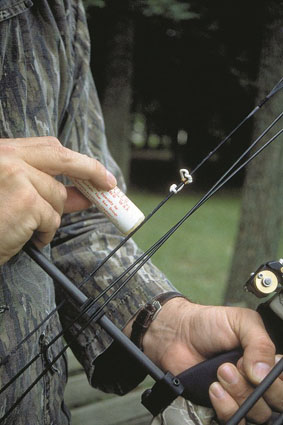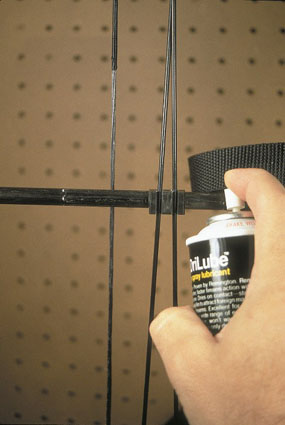 Don’t forget routine maintenance. Wax strings often to curb daily wear. |
As the Bowhunter’s Addendum to Murphy’s famous observation that anything which can go wrong will, I propose the following: “…And then something else will go wrong.”
Fine tuning a hunting bow setup, and keeping it tuned, is the only way to reduce the chances of a muffed opportunity. It will improve the odds that when that long-awaited and hard-earned opportunity presents itself, everything will unfold as you envision it, with a perfect double-lung shot and a short bloodtrail.
Silence Is Golden
Noise is a major bugaboo. This can in turn be broken down into two categories. One is the noise made by the bow and string when the arrow is released. Some bows are inherently noisier than others. All else being equal, faster bows are noisier than slower bows, and lighter bows are noisier than heavy bows—but all else is seldom equal. Superior designs, materials, and the right accessories can produce reasonably quiet, very fast bows—and the opposite is equally true.
Start with your string. String silencers come in a variety of styles and materials, and they are simple and effective.
Stabilizers add weight and absorb vibrations, both of which can significantly reduce noise levels. For the hunting bow, the point of diminishing returns occurs quickly; while longer stabilizers do a better job of steadying the bow and decreasing torque, short stabilizers diminish noise almost as well and are a much better choice for hunting. The added weight might be considered a downside, but many bowhunters discover that the added weight makes for a steadier-aiming bow, in addition to a quieter bow with less recoil.
The other kind of noise involves arrows clattering against risers or squeaking over rests, unlubricated axles squeaking, vanes or (especially) feathers scraping against one another or against tree bark or clothing, or various loose accessories rattling, either before or during the shot.
The fixes for these potential problems are relatively straightforward. First, make sure everything is tightened down. In the case of modern speed bows, in particular, accessories such as rests, sights, and quivers are sure to vibrate loose over time.
Various sorts of adhesive-backed fleece, wool, or moleskin padding are an easy and virtually sure-fire way to prevent the noise of arrows clattering against risers when they are being nocked by hunters with buck fever, or in the event they fall off the string. Don’t be stingy with the stuff; cover every surface an arrow could hit.
Squeaky arrow rests can be a real headache. Frequently examine and replace the shrink tubing on your shoot-through rests. Teflon-coated rests are available to keep this noise down, as well. Moving parts can clack and bang loudly with each shot. Quiet them by carefully applying shrink tubing or adhesive-backed padding to exposed parts that come in contact. Make these modifications before tuning your bow, if possible.
Long before it comes out completely, the foam material in quivers can become loose enough to vibrate with each shot. Check it from time to time. Place arrows in the quiver so that that rattling broadheads and shafts will not generate noise with each shot.
 Spray-on Teflon is ideal for cable guards. |
As the Bowhunter’s Addendum to Murphy’s famous observation that anything which can go wrong will, I propose the following: “…And then something else will go wrong.”
Lubrication can prevent some noises, but lubricate sparingly. Too much goop will attract grit and dust. In some cases, such as cable guards, dry lubricants such as graphite or spray on Teflon work best. Where oil is required, an infrequent drop or two will normally do the trick.
Adjustments
Peeps, nock points, and nock loops slide up strings; sight pins move; strings stretch; cams go out of time. Get in the habit of checking the tightness of peeps, nock points and loops, and sight pins. In addition, mark the locations of these items with an indelible marker of some sort. Not only will this tell you at a glance if any of these adjustments is off, but it makes replacing a pin, a peep sight, or a nock loop a quick and easy process.
Durability Counts
Fine-tuning starts with selecting the right bow and accessories. If they aren’t durable enough to stand up to hunting conditions, they could cost a P&Y buck. Whether it’s sights, release aids, quivers, rests or other accessories, durability should always be a consideration.
Spare Parts Dept.
No setup is really fine-tuned if it doesn’t include spare parts. Who knows how many hunts are unnecessarily ruined every year because of a lost release aid, a broken nock loop, a missing clip or bolt? Carry a few basic spares and the tools required to install them.
Know Your Stuff
Quiet, durable, and otherwise finely tuned setups are wasted on hunters who lack familiarity with their equipment. A hunter wears a new hat and the bill gets in the way when he draws. Another hunter puts on gloves, and his anchor point changes. The chair in the new ground blind squeaks, the rangefinder cord catches in the bowstring, the new mechanical broadheads rattle loosely in the quiver, and on and on. The key to avoiding these problems is simple: Practice with all the equipment you’ll using, wearing all the clothing you’ll be hunting in, and simulating hunting conditions as much as possible. If you’re going to have problems, encounter them in practice sessions where they can be resolved before they become another tale of woe around a campfire.






